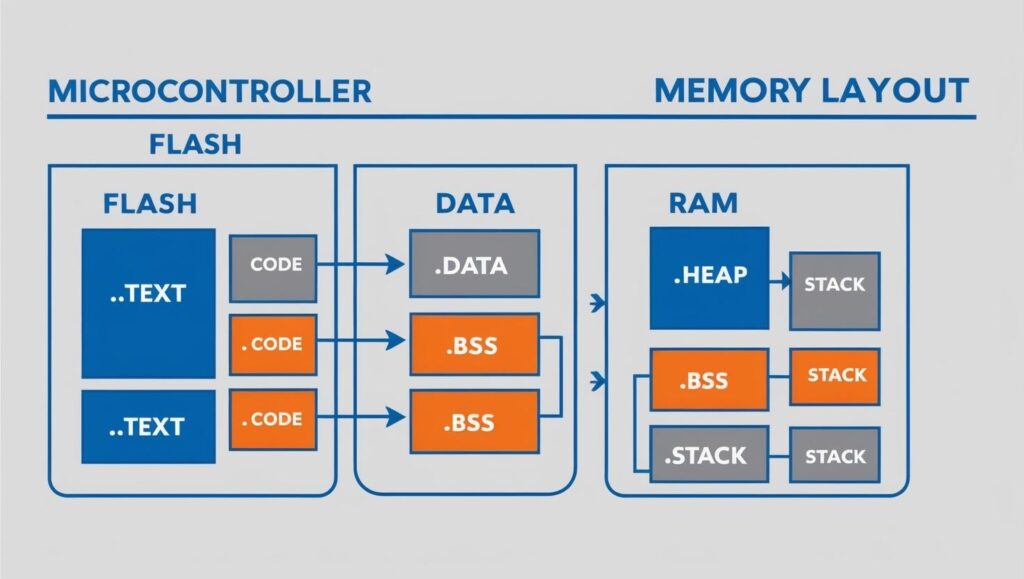Introduction: The Hidden Magic of Embedded Systems
When you first start working with embedded systems, you’re faced with a variety of challenges. From configuring hardware to writing efficient code, each step brings you closer to creating something extraordinary. But there’s one hidden aspect of embedded systems development that many don’t think about until they encounter a problem: Linker Scripts.
At first glance, a linker script might seem like just another technical detail—an arcane file that no one wants to deal with. However, once you understand its role, you’ll realize it’s nothing short of a wizard’s spell for managing memory in your system. It controls the layout of your program in the device’s memory, ensuring that the code, variables, stack, and heap are all placed in just the right spots.
Let’s take a deeper dive into the world of linker scripts and see how this seemingly invisible force works its magic! ✨

1. What Exactly is a Linker Script?
🔍
A linker script is a configuration file that tells the linker (the tool that combines object files into an executable) how to arrange different sections of your program in memory. These sections could be:
- Code (
.textsection) - Data (
.datasection for initialized variables) - Uninitialized data (
.bsssection) - Heap and stack
Without a linker script, the linker would have no idea how to manage the memory of your microcontroller. It’s like having an amazing puzzle with all the pieces scattered across the table—someone needs to put it together! 🧩
2. Memory Layout: The Skeleton of Your Program
🧠
The first step in creating a linker script is defining your memory layout. You specify which part of the memory is for code, which part is for data, and so on. Here’s how we define memory regions in our linker script:
MEMORY
{
FLASH (rx) : ORIGIN = 0x08000000, LENGTH = 128K
RAM (rwx) : ORIGIN = 0x20000000, LENGTH = 20K
}
- FLASH: This is where your program code will be placed. It’s Readable (r) and eXecutable (x), meaning your microcontroller can fetch and run instructions from here.
- RAM: This is where your program’s variables, stack, and heap live. It’s Readable, Writable, and eXecutable (rwx), meaning your processor can read, modify, and execute code here when necessary.
These regions are essential because microcontrollers have limited memory, and the linker helps ensure everything is stored in the right place. 📍
3. Section Mapping: Where the Magic Happens
✨
This is where the real fun begins! You’ll map your code and data sections to the memory regions you’ve just defined. Here’s an example:
SECTIONS
{
.text : {
*(.text)
*(.rodata)
} > FLASH
.data : {
*(.data)
} > RAM AT > FLASH
.bss : {
*(.bss)
} > RAM
}
- .text: This is where your program code goes. You want your processor to run this code, so we place it in FLASH memory.
- .data: Contains initialized global and static variables. These variables are placed in RAM but loaded from FLASH when the program starts (via the
AT > FLASHdirective). - .bss: Holds uninitialized global and static variables. These get zeroed out in RAM at runtime.
With these mappings, the linker ensures that everything is where it needs to be, without you needing to manually assign each byte of memory! 💡
4. The Stack: An Essential Memory Region
🔋
Every program needs a place to store temporary data and manage function calls. This place is the stack, which grows and shrinks as functions are called and return. Here’s how to reserve space for the stack in your linker script:
.stack : {
. = . + 0x1000 /* Reserve space for stack (4KB) */
} > RAM
By reserving 4KB of RAM for the stack, you’re ensuring that there’s enough space for your program to manage function calls and local variables efficiently.
5. Optimizing the Program’s Layout
🔧
The final touch involves ensuring everything is properly aligned. In embedded systems, alignment is crucial for performance and reliability. You can use the ALIGN() directive to ensure that the program ends on a boundary that makes sense:
end_of_program:
{
. = ALIGN(4); /* Align to 4-byte boundary */
}
This ensures that your program is properly aligned for the microcontroller’s architecture. 🛠️
Conclusion: The Silent Hero
🦸♂️
Linker scripts might seem mysterious at first, but they play an essential role in the smooth functioning of embedded systems. By managing how code and data are arranged in memory, they make sure everything runs efficiently and without surprises.
Next time you encounter a linker script, instead of seeing it as a roadblock, recognize it as the silent hero of your project—guiding the code and data to their rightful places. 🌟